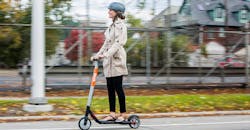As motor vehicle ownership rates in developed nations stagnate, traditional automobile manufacturers are looking to diversify their portfolios to find news sales opportunities. Motor vehicle component suppliers like Bosch, Continental, and Brose, were among the first to diversify their component offerings to include those designed exclusively for e-bikes, while BMW and Audi were among the first automakers to expand into e-bikes.
However, the recent arrival of GM and Ford into this mix could be a catalyst for an automotive invasion, as this may spur other big automakers to follow suit.
With US auto sales stalling, GM announced in November 2018 that it would enter the burgeoning e-bike industry. GM’s e-bikes will include both compact and foldable models, which should provide the company access to multiple e-bike niches—urban, ampus, scenic, athletic, and many more. Because nearly all of the e-bikes currently on sale in the US are imported, GM could leverage its large U.S. manufacturing operations to more quickly serve retailers, giving it an advantage over foreign products.
Rather than selling directly to consumers, Ford is focusing on partnerships with ride-sharing operators to offer its bikes and e-bikes. For example, the company participates in the Ford GoBike program with bike-share operator Motivate International (recently acquired by Lyft), which rents Ford GoBikes to customers in San Francisco. In April of this year, the program was expanded to include Ford’s Ford GoBike Plus e-bikes.
Ford further invested in alternative electric vehicles when it acquired electric scooter maker Spin just days after GM’s e-bike announcement. Following the merger, Ford expects to expand the presence of Spin’s dockless sharing scooters from 13 cities to 100 over the next 18 months.
A Flock of Birds
One key segment for electric two-wheelers, especially in large, congested cities and university campuses, is the micromobility market. According to the National Household Travel survey of 2017, about half of the vehicle trips in the country are less than 3 miles. As a result, many commuters are hopping on scooters and e-bikes for these short jaunts, partly for their allure, but also to escape traffic.
Lime and Bird—the two leading e-bike and scooter suppliers, respectively, of large cities—are the most prominent players in this segment. Their competitive base rate of $1, plus an additional 15 cents per minute, provides an inexpensive alternative to cabs or rideshares. These products are already in many major US cities and have recently expanded into Europe.
Motorcycle Moves
Trends indicate that e-bikes are also the next move for motorcycle manufacturers—if they aren’t already producing them, that is. Harley-Davidson’s growth plan through 2022 includes a series of light, off-road motorcycles and their first electric motorcycle, both of which are expected to debut next year. Considering Harley-Davidson’s historically heavy-duty portfolio, the introduction of an electric motorcycle allows them to pursue a new customer base. This offers future potential as they establish an electric/light offering.
And Harley-Davidson isn’t the only one. Yamaha, a diverse manufacturer of goods and equipment, released a line of four e-bikes in April of this year that target a few different segments. In addition to the recreational market, Yamaha’s models are priced and named to also appeal to the trending micromobility market. The Urban Rush model is marketed to urban commuters with the tagline “total pavement domination.”
Mini-Luxury
While most e-bike manufacturers are trying to focus on average commuters and urban riders, high-end automobile manufacturers are also bringing e-bikes to the luxury markets they currently serve.
Luxury e-bikes are designed with top performance features and materials, but they definitely come at a cost. BMW’s $4,000 e-bike, for example, is comparable to an electric vehicle with a 250W motor and a battery that can last for up to 62 miles. And soon after Audi’s 2012 merger with Ducati, the two companies leveraged their dual expertise in high-end automobiles and motorcycles to produce the Sport e-tron, one of the lightest carbon e-mountain bikes on the market.
The bike features the Bosch Perfomance CX motor, generating maximum torque of up to 75 Nm and a price tag of approximately $18,000.
These vehicles are not without controversy, as safety and infrastructure issues have cropped up and at times led to citywide bans. Still, as regulations are implemented and infrastructure changes are made, this market may become more appealing to other auto companies.
Natalie Dell is a research solutions representative at the Freedonia Group. This article originally appeared on the Freedonia Group blog.
About the Author
Natalie Dell
Researcher
Natalie Dell is a research solutions representative at the Freedonia Group. This article originally appeared on the Freedonia Group blog.
